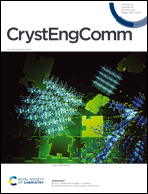Deep-ultraviolet transparent alkali metal–rare earth metal sulfate NaY(SO4)2·H2O as a nonlinear optical crystal: synthesis and characterization†
Abstract
A new alkali metal–rare earth metal sulfate with the formula NaY(SO4)2·H2O has been synthesized using a mild hydrothermal method. It crystallizes in the noncentrosymmetric trigonal space group P3121 (No. 152) with unit cell parameters of a = 6.8191(3) Å, b = 6.8191(3) Å, c = 12.7035(11) Å, and Z = 1. Its structure features isolated [SO4] groups, extending to a three-dimensional (3D) framework linked by [YO9] and [NaO8] polyhedra. Second-harmonic generation (SHG) measurements show that NaY(SO4)2·H2O is phase-matching, with a SHG response ca. 0.6 times that of KH2PO4 (KDP). In addition, the UV-vis-NIR diffuse reflectance spectrum indicates that it exhibits a wide transparency range with a short UV cutoff edge (below 200 nm), suggesting that NaY(SO4)2·H2O is a potential deep-ultraviolet transparent nonlinear optical material. Its thermal stability and IR spectrum were studied comprehensively. Theoretical studies using density functional theory have been implemented to further understand the relationship between its optical properties and band structures.

- This article is part of the themed collection: Crystal Growth


 Please wait while we load your content...
Please wait while we load your content...